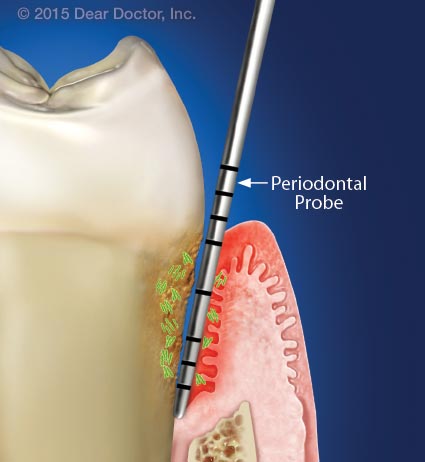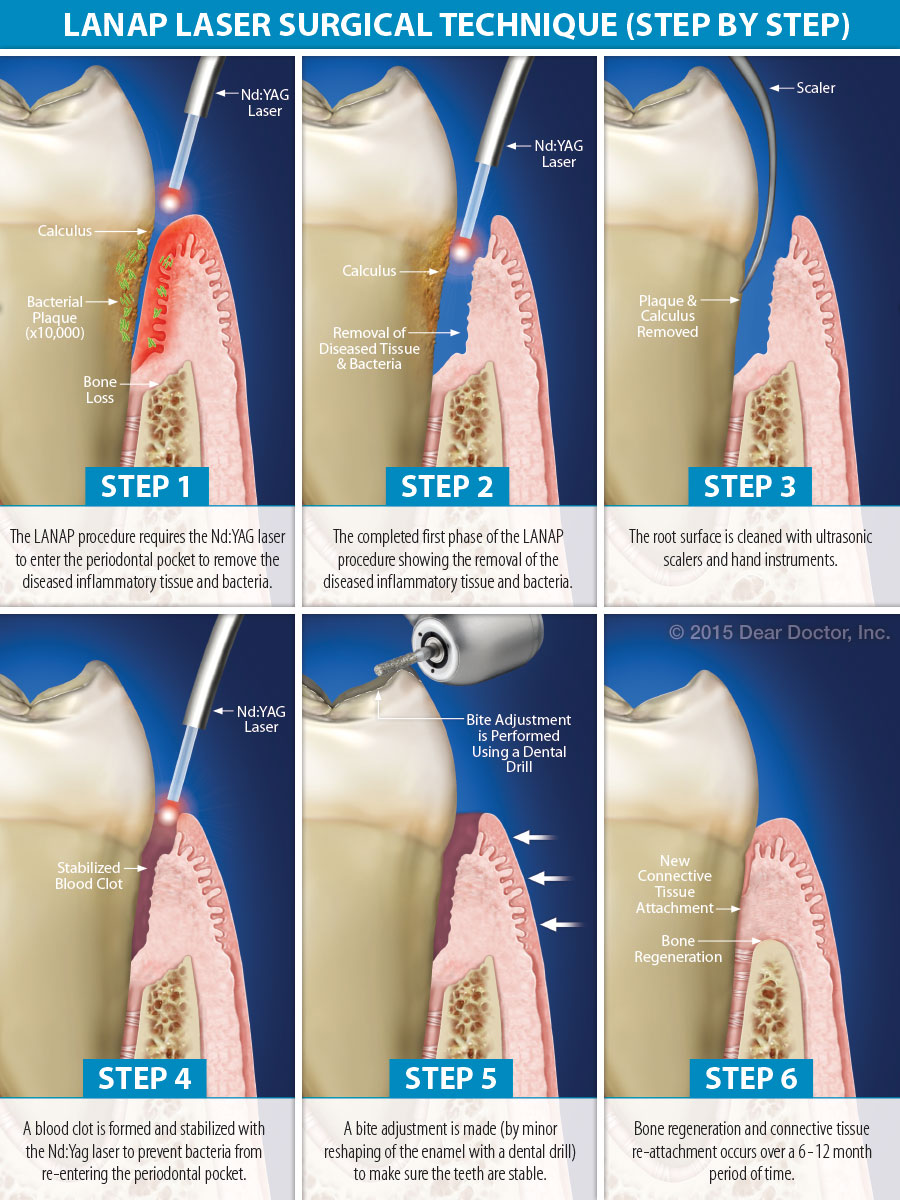Treating Gum Disease With Lasers
An Alternative Treatment for Periodontal Disease
(Continued)
 |
| Diseased periodontal pocket measuring 8 mm, with inflammation, calculus, bacteria and bone loss. |
The LANAP® Procedure
The word “laser” is an acronym for “Light Amplification by Stimulated Emission of Radiation.” Lasers produce an intense and narrow beam of light of one single wavelength. Ordinary “white” sunlight by contrast is a continuum of light of many wavelengths corresponding to the colors of the visible spectrum or rainbow, plus the infrared (heat) and ultraviolet wavelengths that sandwich them.
Simply put, a medical laser device includes: a source of electricity; mirrors to direct the light beam; a crystal, gas, or set of semiconductors that when stimulated emit specific wavelengths of light; and fiber optics that deliver the light energy. The material that produces the light — the active medium — determines the specific wavelength properties of the laser and therefore what it can do in the human body.
A specific pulsed Nd:YAG laser has been developed for the LANAP® protocol, also known as Laser Assisted New Attachment Procedure. It consists of neodymium (Nd) atoms distributed in an yttrium aluminum garnet (YAG) crystal. When the neodymium is excited with a jolt of electricity, it emits a burst of infrared light with a wavelength (color) of exactly 1064 nanometers. The laser light is delivered via a very small fiber optic about the width of 3 human hairs that is directed precisely at the tissues in question. This color of light is transmitted through normal cells like sunlight through a windowpane, but it seeks out and “vaporizes” the darkly pigmented bacteria known to cause periodontitis.
The basic mechanism of the Nd:YAG laser action involves the transfer of the laser light energy into heat within the bacteria or the diseased cells of the tissues that are being treated. The pulsing of the laser energy limits the potential collateral damage from the spread of excessive heat.
 |
| LANAP® Laser Surgical Technique (Step by Step)
Click to enlarge |
The Nd:YAG laser’s benefits are based on its ability to remove the sub-gingival (“sub” – below; “gingival” – gum) diseased connective tissue and pocket lining, and to kill bacteria. Because of its precision, the Nd:YAG laser can be used by specially trained dentists to remove diseased tissue close to the margins of where it meets healthy tissue without damaging the latter.
Once the diseased lining cells of the periodontal pockets are destroyed with the laser, the root surfaces of the teeth are thoroughly cleaned with ultrasonic scalers and, sometimes, with traditional handheld instruments. After the root surfaces are cleaned, the living cells in the supporting bone are stimulated to release growth factors. Bleeding, a normal part of any surgery and necessary for clot formation and normal wound healing, is stabilized by the Nd:YAG laser.
The LANAP® procedure developed for periodontal gum treatment is thus minimally invasive and can result in less tissue removal and bleeding, plus less discomfort and tissue shrinkage (gum recession) than conventional periodontal surgery — and without scalpels or sutures.
What The Studies Show
The LANAP® procedure is considered minimally invasive whereas traditional flap surgery is considered to be invasive. However, in terms of results, current evidence shows that the LANAP® procedure that includes use of the Nd:YAG laser and conventional surgical therapy using the scalpel provide similar improvement in the treatment of moderate to advanced periodontitis.
Several years ago, Raymond Yukna, DDS of Louisiana State University studied the microscopic structure of periodontal tissues treated with the LANAP® procedure and allowed to heal for three months. His study showed growth of new bone and new connective tissue, with the tissue structure regenerating back to its normal configuration.
Mark Reynolds, DDS, PhD of the University of Maryland recently reported on an ongoing study that recruited over 50 people from 3 dental schools and 2 private practices. Statistical analysis at 6 months post-treatment showed the LANAP® procedure and traditional periodontal surgery to be equivalent in reducing pocket depths and both were significantly better than controls. The pain diaries of the subjects, however, showed significantly greater comfort in the areas treated with the LANAP® procedure than those with traditional surgery.
Most recently, Marc Nevins, DDS of Harvard University conducted a second study — this time waiting 9 months after the LANAP® procedure for additional healing. His 2012 results provide further clinical evidence that it can induce periodontal regeneration.
The Bottom Line
A proper diagnosis of your gum condition is crucial to successful treatment. After all, you have to have the right tools for the right job, and if your periodontal condition is very advanced, the LANAP® procedure might not be the only tool for your case. That’s where the knowledge, experience, skill and know-how of your dentist or periodontist will be fundamentally important.
It is now documented that treating gum disease with the LANAP® protocol appears to have improved outcomes at least to the extent that it makes the treatment procedure less invasive, more comfortable and possibly enhances the body’s ability to repair the damage caused by the infection. At this point in time, it can be said that this laser periodontal treatment can be successful with the LANAP® protocol. However, it is important to keep in mind that lasers can’t simply cure gum disease with a single zap. Rather, control of periodontal (gum) disease and maintenance of health is an ongoing process dependent upon: long-term daily oral hygiene (biofilm control); regular periodontal maintenance at the dental office (often at three-month intervals); and professional monitoring and evaluation.




